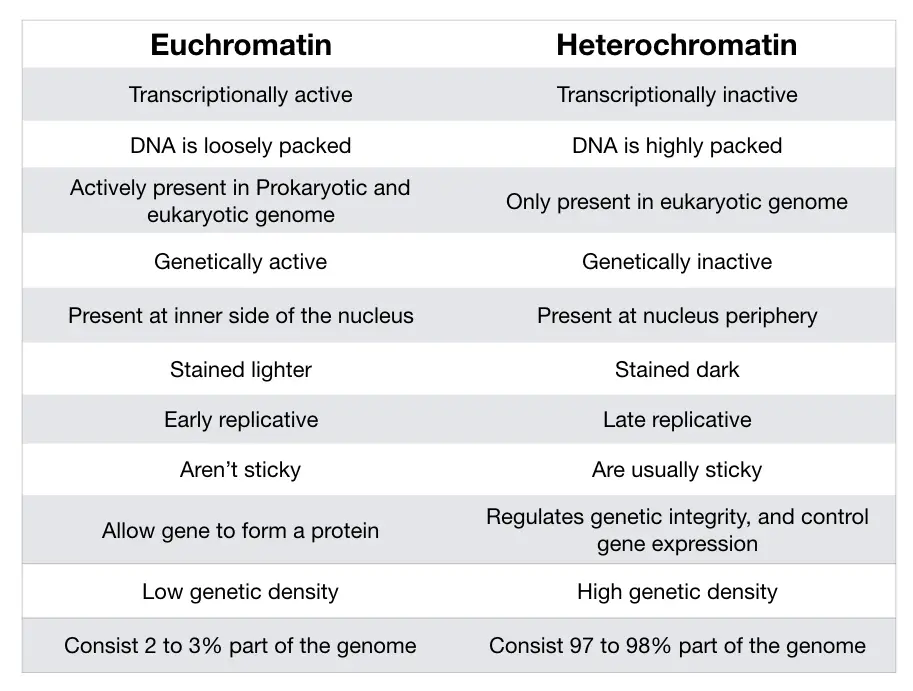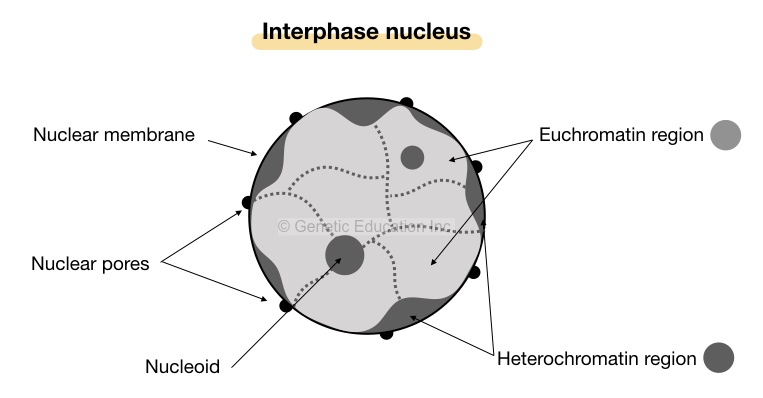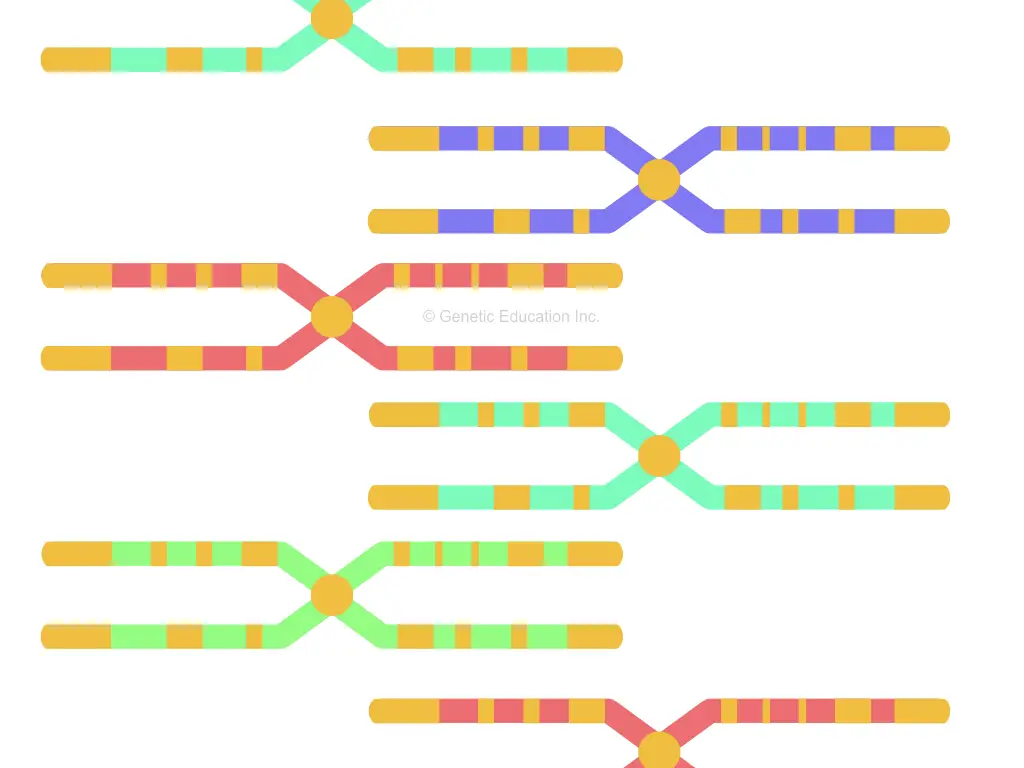“The euchromatin region is known as the gene-rich region while the heterochromatin region is known as the gene-less region.”
Types of chromatin- euchromatin and heterochromatin are located on chromosomes. DNA and protein interaction makes chromosomes- the highest level of DN packaging having two pairs of sister chromatids.
The chromatids are formed by the network of chromatin fibers. A chromosome is an inheritance unit of a cell made up of DNA and proteins. To make DNA fit inside the cell nucleus the DNA interacts with the histone proteins and manufactures a chromosome via nucleosome, bead-on-string, chromatin and chromatids structures.
The whole process of constructing a chromosome is known as DNA packaging. It is so crucial to facilitate replication, transcription and translation.
The chromosome appears during the metaphase stage of the cell division whereas, chromatin regions (euchromatin and heterochromatin) are vision only during the interphase. Henceforth it is known as interphase chromatins.
Both types of chromatins viz the euchromatin and heterochromatin are different in terms of structure and function. To understand the present topic very precisely, we need to first understand what chromatin is. For that, you can read our previous article: Inside Chromatin: Definition, Structure, and Function.
Let me explain to you in brief, chromatin is a higher level of DNA and protein organization that makes two distinct regions, one takes part in transcription while the other one is transcriptionally inactive.
The inactive or transcriptionally inactive portion of our genome is known as non-coding or junk DNA or gene fewer regions. It actually does not manufacture proteins but helps in regulating gene expression, indeed.
In the present article, we will understand how the euchromatin and heterochromatin regions are different, it’s structure and their importance in gene expression and protein manufacturing.

Key Topics:
Differences between Euchromatin vs Heterochromatin:
The euchromatin structure is a loosely packed, less organized chromatin whilst the heterochromatin region is tightly packed and most condense chromatin structure.
Histone proteins play an important role in deciding which type of chromatin to form during the DNA packaging process. Further to this, the euchromatin region is fixed or can’t spread while the heterochromatin region can spread into the euchromatin region. This means that genes may become inactive as per the signal given by a cell.
But thanks to the histone-modifying enzymes, the boundaries between the euchromatin and heterochromatin regions are defined. Inactivation of genes may cause serious health issues.
The euchromatin region is considered a genetically active region while the heterochromatin region is considered a genetically inactive region.
Now let us understand the reason why!
The euchromatin is loosely packed which means the histone and DNA interaction is loose, allowing enzymes to bind on DNA and perform catalytic reactions like transcription.
But it isn’t the case with the heterochromatin region, here, the DNA is so tightly packed or wrapped that it does not allow enzymes to bind or work.
Consequently, transcription can’t happen.

Transcription is an intermediate stage of manufacturing a protein, we know that; however, a cell must perform it. Euchromatin can do it but heterochromatin can’t.
Put simply, euchromatin regions are transcriptionally active and make a protein while the heterochromatin regions are transcriptionally inactive and can’t form a protein.
When we talk about replication, the chromatin collection of euchromatin is early replicating while the chromatin collection of the heterochromatin region is late replicating.
Here also, the reason is the same. The heterochromatin is packed so compactly that polymerase can’t do replication as fast as it does do on the euchromatin region, henceforth, the euchromatin replicates early while the other one replicates late.
Genes are located in euchromatin regions. It is referred to as ‘gene-rich regions’ while the heterochromatin regions are referred to as ‘gene less regions’.
Genes are function pieces of DNA that make protein, therefore almost all the genes are located in the euchromatin region. But not in the heterochromatin region.
Their property to transcribe into protein makes the euchromatin region more genetically variable. It can produce variabilities. On the other side, the heterochromatin region is so dense that it maintains the structural integrity of the genome.
Thus in terms of function, the euchromatin regions form proteins while the heterochromatin regions regulate gene expression and maintain the integrity of the genome.
Transcriptionally active chromatins are present in the inner side of the nucleus while the inactive (heterochromatin) regions are located at the periphery of the nucleus during the interphase of cell division.
However, during metaphase, chromosomes consist of both types of chromatins and arrange one after another (therefore we get light and dark bands simultaneously).
Only around 2% of the genomic portion is genetically active or contains genes while the rest is inactive. Approximately 97 to 98% of the genome is just junk, inactive heterochromatin.
The euchromatin has low DNA density while heterochromatin has high DNA density.
The gene-rich region- euchromatin is commonly found in both prokaryotic as well as eukaryotic organisms. But heterochromatin is not present in prokaryotes.
The prokaryotic genome is small, simple and less complex. Meaning, have less non-coding regions, they regulate gene expression and protein formation by the specialized model known as Operons. For example, trp and lac operons.
The euchromatin is present in a single form whilst the heterochromatin region is further divided into two portions viz the constitutive heterochromatin region and the facultative heterochromatin region.
Euchromatin regions consist of active genetic elements such as exons or exonic sequences while the heterochromatin region consists of introns, transposons, regulatory elements and other noncoding DNA.
So far we have discussed so many differences between euchromatin and heterochromatin, But you may wonder, how does someone discriminate between both regions, how is it visible?
A technique known as karyotyping is utilized to see chromosomes. Techniques like the Giemsa-trypsin-Giemsa banding make different banding patterns on chromosomes, using which we can discriminate between different chromosomes and chromatins.
Now here the next big thing comes!
The euchromatin region stains lightly while the heterochromatin region stains darker by GTG banding.
The reason is that the loosely packed DNA of euchromatin absorbs less stain in comparison with the denser heterochromatin region. We have the image of it here:

The euchromatin is located on the arms of the chromosome while the heterochromatin is located in the centromeric and telomeric portion of the chromosomes, majorly.
If we discuss the molecular structure of both; the nature of nucleotide sequences also varies between both. The euchromatin region is simple, consists of less repetitive DNA and GC rich regions while the heterochromatin region is highly repetitive and consists of GC rich regions.
Similarities between euchromatin and heterochromatin:
There are so many differences between the two types of chromatins, though, they have some similarities as well.
- Both are sequences of DNA made up of polynucleotide chains, however, have different functions.
- Both are arranged on chromosomes via the primary nucleosome assembly.
- The euchromatin and heterochromatin are visible more distinctly during the interphase stage of the cell division.
- Both chromatins can interact with a special type of protein known as histones to package on chromosomes.
Euchromatin in a nutshell:
Only around 1.8% to 2.0% (or sometimes 3%) regions of a human genome are gene-rich segments, meaning, the euchromatin. The DNA sequences of the euchromatin region are actively involved in the replication, transcription and translation and thus form proteins.
The euchromatin regions look light pink under the microscope. In the nucleus, the euchromatin region appears in the middle scattered to allow enzymes to perform various catalytic reactions.
Related article: Differences Between Chromosome and Chromatid.
Heterochromatin in the nutshell:
The 98% portion of the genome is a transcriptionally inactive- heterochromatin region. It appears darker under the microscope. Although it can’t tailor proteins, it regulates the expression of genes. The heterochromatin regions are not present in the prokaryotic genome.
In the nucleus, it appears near the nuclear membrane as darkly stained, irregular dense particles. Two types of heterochromatin are present in the genome; constitutive heterochromatin and facultative heterochromatin.
Frankly speaking, both terms are a bit complicated to understand, at least for a beginner. Let me try to explain it to you.
The location of constitutive heterochromatin regions is fixed on chromosomes, commonly found in telomere and centromeres. Although the facultative one is not fixed.
Put simply, the constitutive heterochromatin is totally inactive and repetitive sequences while the facultative heterochromatin is variable, in some cells it may convert into euchromatin and turn on transcription. And this one is the main difference between both.
Due to this reason, the constitutive regions remain unchanged between cells or organisms while the facultative one is not consistent between cells.
The unexpressed consecutive regions of chromosomes- 1, 9, 16 and Y are examples of consecutive heterochromatin while the inactive X chromosome is the example of facultative heterochromatin. In females, the process of inactivating one X chromosome varies among cells and individuals to regulate the expression of the X chromosome.
Related article: What is Heterochromatin?- Constitutive and Facultative Heterochromatin Explained.
Wrapping up:
Though euchromatin and heterochromatin are different, the heterochromatin region can spread and become euchromatin but the reverse is not possible for euchromatin. Also, not all the regions of the heterochromatin portion are inactive, as per the recent findings.
Some sequences may undergo transcription and make RNA but can’t form a protein. It helps in gene regulation, instead. RNAi- mediated gene regulation is a pivotal process that exists in a eukaryote. RNA interference uses micro or small interfering RNA to degrade target mRNA thereby facilitating gene silencing.
By forming a complex like RISC, RNAi-mediated gene regulation is the pivotal process in the eukaryotic genome.
Also, there is another point to discuss here. The heterochromatin regions are not there in prokaryotes which means the repetitive DNA evolved late during the evolution process to facilitate and regulate gene expression.
Summary:
| Euchromatin | Heterochromatin | |
| Role in transcription | Transcriptionally active | Transcriptionally inactive |
| Packaging | Loosely packed | Tightly packed |
| Organization | Less organized | Highly organized |
| Condensation | less condense | More condense |
| Property | Fixed- can’t spread | Moving- can spread to the euchromatin region |
| Genetic role | Genetically active | Genetically inactive |
| Replication | Early replicative | Late replicative |
| Gene region | Gene rich region | Gene less region |
| Variability | Produce variability | Non-variable |
| Function | Make a protein | Maintain genomic integrity and regulate gene expression. |
| Genomic portion | 2 to 3% | 97 to 98% |
| DNA density | Low | High |
| Gene density | High | Very low |
| Organism | Prokaryotes and eukaryotes | Eukaryotes only. |
| Type | None | Constitutive heterochromatin and facultative heterochromatin |
| Sequences | Exons | Introns, regulatory elements, transposons etc. |
| Staining | Stain light | Stain dark |
| Location | On the arms | On the telomeric and centromeric regions |
| Nature of sequences | Less-repetitive | Highly repetitive |
| GC rich regions | Less | More |
Conclusion:
Making protein from DNA has a complex pathway including varied enzyme and regulatory elements. Conversion from heterochromatin to euchromatin makes things possible. when the entire mechanism gets disturbed, it will cause serious health issues.
Conclusively, we can say the major difference between either is their functionally, and structure. One makes proteins while the other regulates gene expression; One is less repetitive and GC-rich while the other is highly repetitive and GC-rich. We can say broadly, the function of ‘chromatin is to form protein and regulate gene expression.
Sources:
Murakami Y. (2013) Heterochromatin and Euchromatin. In: Dubitzky W., Wolkenhauer O., Cho KH., Yokota H. (eds) Encyclopedia of Systems Biology. Springer, New York, NY. https://doi.org/10.1007/978-1-4419-9863-7_1413.


